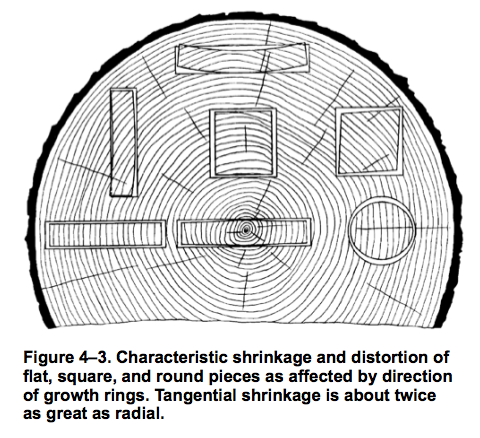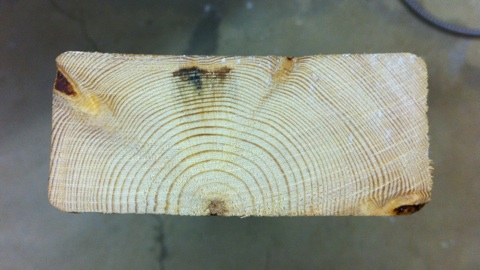Cupped wood
November 14, 2010 at 11:07 PM by Dr. Drang
I needed a short length of 2×4 today for a bit of home maintenance, so I rummaged through my small stock of unused ends, found one a little longer than I needed, and cut it to fit. When I looked at the fresh-cut end, I noticed that the piece was cupped, its cross-section warped into a shallow U.
This is exactly the way my old copy of the Wood Handbook said it should warp. The Wood Handbook is put out by the Forest Products Laboratory up in Madison, Wisconsin and was one of the textbooks used in a structural timber design class I took about 30 years ago. My copy of the Handbook is printed, of course, but the current edition is a PDF. It still has the image that came to mind when I saw the cupped 2×4:1

Wood warps because it shrinks as it dries from the green state, and it shrinks different amounts in different directions. Directions within a piece of wood are given in terms of its growth:
- The longitudinal direction is up the trunk, in the long direction of a piece of lumber. You’d probably call this direction along the grain or with the grain.
- The radial direction is horizontally straight out from the center of the trunk, like the radius of a circle.
- The tangential direction is also horizontal, but tangent to the growth rings, which are, except around knots, roughly circular.
Shrinkage2 is usually negligible in the longitudinal direction,3 but is typically 2-10% in the other directions, with tangential shrinkage roughly twice the radial shrinkage. As the diagram shows, this can lead to warping of the cross-section, depending on where the piece came from within the trunk.
My 2×4 is a bit unusual in that its lower edge was cut just off the heart of the tree, making it that edge almost perfectly radial. It shrunk much less than the more tangential upper edge, leading to the cupped shape. If I were teaching a course in wood behavior, I’d keep a piece of this 2×4 around as an ideal demonstration of the difference in shrinkage.
OK, I know the few regular readers I have come here for the computer nerdery; sometimes my native engineering nerdery pops out.
-
No, the diagram didn’t flash in my head 30 years after I last saw it; I’ve used that book and referred to the diagram many times in between. But it was the first thing I thought of when I picked up the 2×4 after cutting it. ↩
-
Reaction wood is the that part of the trunk near a branch that was stressed during growth by the weight of the branch. Unlike normal wood, reaction wood can shrink a few percent in the longitudinal direction. A mixture of reaction wood and normal wood in the same piece of lumber often leads to a curved and twisted piece. ↩

